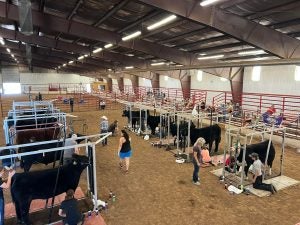The show is over as you walk into the barn aisle, but youth are still pouring over neatly aligned rows of calves that are washed and blown. The excitement is palpable; at first glance, it almost looks like a NASCAR pit crew. One exhibitor is fitting legs, another works on the tail head, and the third brings products to the stand. A judge stands by with a timer, while another walks the aisles reviewing the youth’s work. They’re not prepping for the show or sale — they’re competitors in a team-fitting contest.

When an animal makes it to the show ring, there are hours that go into preparing that animal, and typically, a team of parents and even professionals make that happen.
But what happens if you and your team consisted of only youth exhibitors and you only had 30 minutes to make your animal the best one in the barn? That’s where team fitting contests come in!
Whether you’re a member of a local fair board or headed to a national junior livestock show, this might be one to add to your repertoire. Fitting contests challenge youth to work in a team-oriented atmosphere to get the contest’s chosen species ready for the show ring — all under the onus of time limits and the judge’s eye(s).
While rules and setup for fitting contests will vary depending on the show, this is a contest that can be not only fun but educational. Teams may range anywhere between two to four people. Some competitions are split into age divisions. Others require senior members to have at least one junior member on board or a combination of novice, intermediate (or junior), and senior members. Time limits range from 30 to 60 minutes for these contests.
“It really is true, that teamwork makes the dream work. That’s where you’ll see the outcomes as far as this contest,” said Matt Danetclaw, Weaver Livestock consultant. “We were looking for a contest to fill the time slot during the fair with an activity for the kids. In the past we’ve done barnyard Olympics, skill-a-thons, and judging, but we wanted to involve more of the youth who were exhibiting and allow for greater participation. They thought a team fitting contest would offer a level playing field for youth.”
How do you judge a fitting contest?
Judges typically evaluate the team’s ability to fit the animal within a limited timeframe. Some of these contests will require contestants to fit legs, while others will require the entire animal to be fit during the allotted time. Judges will review the youth’s organization of supplies and equipment, teamwork, and safety.
At the end of the contest, the team’s final results are tallied. A showmanship contest may finish the contest, or simply, a review of the animals presented and time for judges to ask the contestants questions.
How can you hold a fitting contest?
One way to hold a fitting contest is to require youth to supply their own clean show animal and all supplies. Another way is to apply for sponsorship by companies such as Sullivan Supply or Weaver Leather Livestock. Nonprofit organizations may fill out a donation request form detailing the event well in advance.
If selected, the companies will often provide supplies for the fitting contest, including items such as an adhesive, comb, paint, finishing spray, and a breakdown product for after the contest.
How do you prepare for a contest?
Because most contests allow youth to select their teams ahead of time, it’s good practice to have a team selected, and to work with them ahead of time. Know the products that you can use if you’re bringing your own, or, if it’s a sponsored event, take some time to get to know the products that the sponsoring company might supply. Come up with a game plan as to how you’re going to use them by practicing fitting your animals at home — just do your parents a favor and save clipping for the contest.
Heidi Crnkovic, is the Associate Editor for AGDAILY. She is a New Mexico native with deep-seated roots in the Southwest and a passion for all things agriculture.



